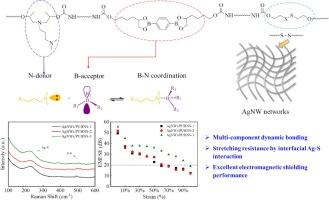基于多组分动态粘合聚氨酯弹性体的机械坚固、自修复和可拉伸电磁屏蔽材料
IF 5.8
2区 化学
Q1 POLYMER SCIENCE
引用次数: 0
摘要
可拉伸自愈合电磁干扰(EMI)屏蔽材料可在机械损伤后自动恢复原有性能,在拉伸状态下仍能保持 20 分贝以上的 EMI 屏蔽效能(EMI SE)。在这项工作中,通过在聚氨酯主链上引入动态二硫键、硼酸酯键和硼氮配位(B-N),制备了一系列高拉伸自修复聚氨酯弹性体 PUBNS-X。研究发现,B-N 配位显著提高了断裂伸长率和拉伸强度。硼酸酯、二硫键和 B-N 配位键的高动态可逆性协同赋予了 PUBNS-X 优异的温度触发自修复性能。在 60 °C 时,PUBNS-X 的机械性能可恢复到 90% 以上。然后,利用动态键合聚氨酯骨架的流动性,将预组装的银纳米线(AgNWs)导电网络引入聚氨酯表面,得到了一系列可拉伸的自修复电磁屏蔽复合材料(AgNWs/PUBNS-Y)。结果表明,AgNWs/PUBNS-Y 的电磁干扰 SE 可达到 ∼55 dB,在 60 °C 下愈合后导电率可恢复到原始值的 82%。对复合材料在不同应变下的电磁干扰屏蔽性能的研究表明,AgNWs/PUBNS-3 的 EMI SE 在 90% 的应变下仍能保持 20 dB。这些复合材料将在柔性可穿戴电子产品、仿生智能材料和软机器人等领域具有广阔的应用前景。本文章由计算机程序翻译,如有差异,请以英文原文为准。

Mechanically robust, self-healing and stretchable electromagnetic shielding materials based on multi-component dynamic bonded polyurethane elastomer
Stretchable self-healing electromagnetic interference (EMI) shielding materials can automatically restore their original performance after mechanical damage, and can still maintain over 20 dB EMI shielding effectiveness (EMI SE) under tensile state. In this work, a series of highly stretchable self-healing polyurethane elastomer PUBNS-X was prepared by introducing dynamic disulfide bonds, boronic ester bonds and boron-nitrogen coordination (B-N) on the polyurethane main chain. It was found that B-N coordination significantly increased the elongation at break and the tensile strength. The high dynamic reversibility of boronic ester, disulfide bond and B-N coordination bond synergistically endowed PUBNS-X with excellent temperature-triggered self-healing properties. The mechanical properties of PUBNS-X can be restored to more than 90 % at 60 °C. The pre-assembled silver nanowires (AgNWs) conductive network was then introduced into the polyurethane surface by taking advantage of the fluidity of the dynamically bonded polyurethane backbone to obtain a series of stretchable self-healing electromagnetic shielding composites (AgNWs/PUBNS-Y). The results showed that the EMI SE of AgNWs/PUBNS-Y can reach ∼55 dB, and the conductivity can be restored to 82 % of the original value after healing at 60 °C. The investigation of the electromagnetic interference shielding performance of composites under different strains showed that the EMI SE of AgNWs/PUBNS-3 can still maintain 20 dB under 90 % strain. These composites will have broad potential applications in the fields of flexible wearable electronic products, bionic intelligent materials and soft robots.
求助全文
通过发布文献求助,成功后即可免费获取论文全文。
去求助
来源期刊

European Polymer Journal
化学-高分子科学
CiteScore
9.90
自引率
10.00%
发文量
691
审稿时长
23 days
期刊介绍:
European Polymer Journal is dedicated to publishing work on fundamental and applied polymer chemistry and macromolecular materials. The journal covers all aspects of polymer synthesis, including polymerization mechanisms and chemical functional transformations, with a focus on novel polymers and the relationships between molecular structure and polymer properties. In addition, we welcome submissions on bio-based or renewable polymers, stimuli-responsive systems and polymer bio-hybrids. European Polymer Journal also publishes research on the biomedical application of polymers, including drug delivery and regenerative medicine. The main scope is covered but not limited to the following core research areas:
Polymer synthesis and functionalization
• Novel synthetic routes for polymerization, functional modification, controlled/living polymerization and precision polymers.
Stimuli-responsive polymers
• Including shape memory and self-healing polymers.
Supramolecular polymers and self-assembly
• Molecular recognition and higher order polymer structures.
Renewable and sustainable polymers
• Bio-based, biodegradable and anti-microbial polymers and polymeric bio-nanocomposites.
Polymers at interfaces and surfaces
• Chemistry and engineering of surfaces with biological relevance, including patterning, antifouling polymers and polymers for membrane applications.
Biomedical applications and nanomedicine
• Polymers for regenerative medicine, drug delivery molecular release and gene therapy
The scope of European Polymer Journal no longer includes Polymer Physics.
 求助内容:
求助内容: 应助结果提醒方式:
应助结果提醒方式:


